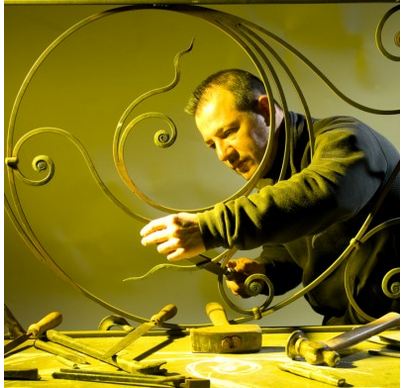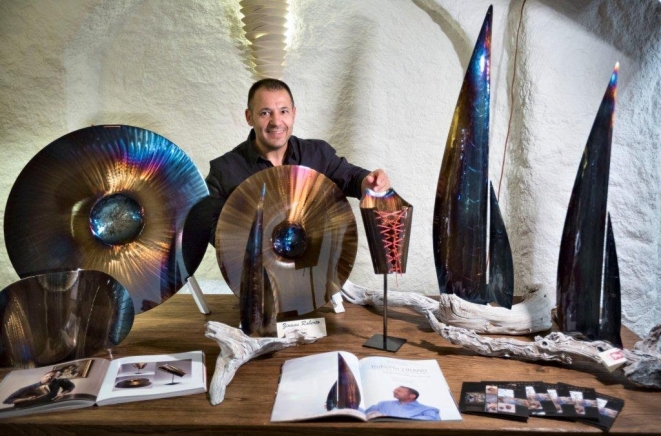Roberto Ziranu and the wrought iron art
The artist of the wrought iron, able to transform a non-precious metal in a very precious metal
In a land whose the subsoil metalliferous wealth have been exploited since the Nuragic Age, a profitable and excellent processing activities of non-precious metals must necessarily be developed.
Among the various non-precious metals used by the Sardinian people, there was the iron and its use has given rise, over time, to a trade as ancient as hard and difficult: that of the blacksmith.
This noble profession comes down to our time thanks to the perseverance of men who often handed down from generation to generation, the old family tradition, adapting it, incredibly, to modernity. Without this passion, today there would be no blacksmiths, energetic and hard-working craftsmen that through the blows of the hammer on hot iron over the anvil, forge and create objects still able to surprise.

It has come a long way the blacksmith, when merely make shoeing of draft animals and manufacture deadbolts, cowbells, handles, door knockers, skewers and objects for the fireplace and for everyday use.
Descendants of this ancient tradition, currently blacksmith artisans produce, among other things, also objects of very high artistic level.
The handicraft of wrought iron has had a millenary tradition of strong and this long and noble history, today, finds a natural outlet in art and splendid artistic expression from diverse, complex and significant aesthetic taste.
And it goes already beyond the beautiful gates, the grates and railings and, more, balustrades from detailed arabesques.
A kind of illustrious art able to turn iron into precious metal.
One of those that can perfectly embody this step is an artist born in Orani, moved to Nuoro, Roberto Ziranu.
His approach to metal is very special. Transforming a piece of inert iron into a piece of art is not a small feat.
The ease and dexterity with which Roberto Ziranu "processes" the iron, shaping it and modeling it, has very few equals.
The manufacturing process of the metal produces true works of art, reinvigorated in aspect and color. The object brought to life, becomes animated, breathes.
We find in his creations the precise and original revisiting of bootlegs and bodices, typical elements of the Sardinian tradition, faithfully reproduced, but also the representation of sails lying on a twisted and polished piece of juniper: aesthetic masterpieces.

In the paintings the color gets lost and alternates in a strong game of lights that exalts the outline of the figures highlighted by the hatching.
His language draws origin and inspiration from archaic shapes and lands with coherence on contemporary expressions and configurations. Elements of sea, of land, of childhood and of tradition. Each work of art is focus on one of these subjects.
His creations have a deep appreciation and are able to getting an important space in the field of art. The artist of Barbagia alternates the classic techniques of manufacturing of iron, such as drive, forging, millwork and curving and those typically artistic techniques, such as incision and flaming that gives to iron the extraordinary golden glare, typical of his works of art.
Great competence, great inspiration and great passion. A bequest that moves generation by generation and that findhere the right explosion in art. The artisan is an artist. His passion and his creativity are precious goods.
Roberto Ziranu is a Sardinian artisan excellence who took part to numerous exhibitions. For instance: the Biennial Festival of Sassari, Porto Cervo International Symposium, New York Craft and Design in the USA, Stia European Biennial of metalworking art, Ajaccio Art and Culture, Milano Sardinia Store, Nuoro Mastros, Orani Cortes Apertas, Cagliari Royal Palace, Real Venaria Torino 150° years of the Unity of Italy, Asolo Internation Biennial of art, Ferrara Internation Biennial of art, Doha Qatar exhibition works of art, Ponte de Sor Portogallo Festival Sete Sois Sete Luas.
The workshop of the metalworker became a lab of art without losing its essence of workshop. The anvil, key element in the formation of the red-hot metal, fixed to the proverbial wood stump, is always an essential element. The blows of the hammer articulate the time and the rhythm of the work.
In the past, from the talent of the metalworker came ancestral, simple and of daily use elements. Today, there are other elements with a rare beauty.
Iron can be treated in different ways. The passage to art is itself a different way of treating this material.
Scratching a pattern into it, giving it a color and immersing it in the fire. Gestures that only a true artist can do; gestures that are able to transform a non-precious metal in a very precious metal.